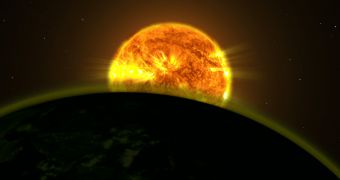Two teams of researchers recently conducted two different studies using the NASA/ESA Hubble Space Telescope, both of which identified water molecules on five planets beyond our solar system. While this is not the first time water is found on exoplanets, these are the first studies to compare water molecule profile between multiple alien worlds.
The first investigation was conducted by experts at the NASA Goddard Space Flight Center (GSFC), in Greenbelt, Maryland, and was led by planetary scientist Avi Mandell. Details of the work appear in the December 3 issue of the esteemed Astrophysical Journal.
The second study was led by investigator L. Drake Deming, from the University of Maryland in College Park. A paper describing the findings was published in the September 10 issue of the same journal. The paper Mandell produced was part of the same series of works on these distant worlds.
Hubble's keen eyes – represented in this study by its Wide Field Camera 3 (WFC3) instrument – were able to detect faint traces of water molecules in the atmospheres of exoplanets WASP-17b, WASP-12b, HD209458b, WASP-19b and XO-1b.
Furthermore, the research groups were able to use these data to accurately compare and measure the profiles and intensities of each of these water molecule signatures. This allowed scientists to significantly boost our understanding of how critical chemicals form on distant worlds.
“We're very confident that we see a water signature for multiple planets. This work really opens the door for comparing how much water is present in atmospheres on different kinds of exoplanets, for example hotter versus cooler ones,” Mandell explains. He is the lead author of the most recent paper.
Both research groups conducted their studies in infrared wavelengths. They looked at how light is absorbed and transmitted from and by the atmospheres surrounding the five target worlds, and then checked to see whether or not any indications of water could be found.
“To actually detect the atmosphere of an exoplanet is extraordinarily difficult. But we were able to pull out a very clear signal, and it is water,” Deming explains. He adds that the key to his team's success was the use of a novel observation technique that increases both exposure times and data accuracy.
All of the planets included in this study belong to the hot Jupiter class, meaning that they are as large as our solar system's gas giants, but also that they orbit around their respective parent stars in orbits as close as Mercury's to the Sun.
“These studies, combined with other Hubble observations, are showing us that there are a surprisingly large number of systems for which the signal of water is either attenuated or completely absent,” explains California Institute of Technology expert Heather Knutson, a coauthor on Deming's paper.
“This suggests that cloudy or hazy atmospheres may in fact be rather common for hot Jupiters,” the Caltech scientist concludes.

 14 DAY TRIAL //
14 DAY TRIAL //